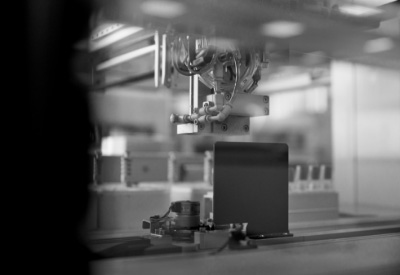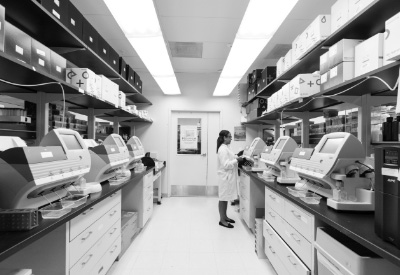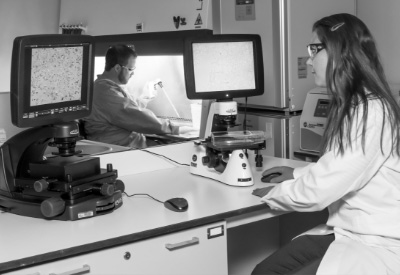
Radiation hardening ensures that microelectronics can withstand the damaging effects of ionizing radiation in space and nuclear environments. City Labs’ NanoTritium™ power sources provide a long-lasting, radiation-tolerant solution, delivering reliable power for over 20 years, even in extreme conditions. This technology is essential for aerospace, defense, and other applications where traditional batteries would fail.

Radiation Hardening Electronics
There are two types of radiation—non-ionizing and ionizing. Non-ionizing radiation involves low-energy particles and is used in many devices we use every day. Microwaves, radios, and ultraviolet (UV) light all harness non-ionizing radiation. Ionizing radiation involves high-energy particles like gamma rays, X-rays, alpha and beta particles, and galactic cosmic radiation (GCR) from space.
In excess, radiation can cause harm to living things. Extreme radiation can also cause damage to non-living things, especially electronics. Building devices to withstand the effects of radiation is necessary to advance our understanding of nuclear energy and space.
What Is Radiation Hardening?
Radiation hardening pertains to developing radiation-tolerant devices and building protection from high levels of radiation in other non-resistant electronics. Radiation hardening and radiation-tolerant technology are of particular interest to City Labs, as we build power sources that can power microelectronic devices in remote areas for over two decades.
Why Is Radiation Hardening Necessary?
There are certain environments and situations that involve tremendous exposure to radiation. As science ventures further into those hazardous areas of study, our technology must evolve concurrently. If we cannot operate machinery under extreme levels of radiation, we will be limited in our scientific endeavors.
Working with nuclear power and radioactive chemicals will damage regular electronics. Radioactive exposure in space prevents our normal technology from working. We need to safeguard our creations against the effects of unexplored environments.
Radiation-tolerant devices and power sources have become the standard for spacecraft and other starbound machinery. However, we are still working to understand the full extent of safeguards we may need in the future.
Space Radiation Effects on Microelectronics
According to NASA’s explanation of space radiation, there are three major portions of the natural space environment that amplify the hazards of radiation:
- Solar particle events
- Free-space particles and GCR
- Trapped particles
Solar particles events occur when protons and other heavy ions are released by total ionizing doses (TIDs), displacement damage (DD), and single event effects (SEEs).
Free-space particles and GCR also pose a threat to inanimate objects. Earth’s magnetic field gives some protection from GCR, but once outside the field, electronics are at risk.
Particles that get trapped in the Earth’s magnetic field include protons and electrons that are released in the same way as regular solar particles.
Each of these ionization radiation sources joins together in affecting satellites and other spacecraft.
Transient Radiation Effects on Microelectronics
Cosmic radiation from space—as well as natural radiation—can significantly damage semiconductors and disrupt digital circuits. A single charged radioactive particle can affect thousands of electrons, sometimes leading to permanent radiation damage.
Below are some of the known effects of radiation on electronics.
- Radiolysis: When electromagnetic or neutron radiation exposure breaks down chemical bonds, materials can crack, corrode, or physically change in a way that ultimately leads to failure.
- Neutron activation: Neutron radiation—caused by nuclear fusion and fission—can cause elements to become unstable isotopes. These materials may then begin to release their own radiation in the form of gamma rays, alpha particles, or beta particles. This radioactivity can last for multiple days or longer and alter devices until they are unusable.
- Ionizing radiation: High-energy ionizing radiation can directly alter the atomic structure of different materials. It can also lead to electrical breakdown of circuits and conductors. The consequences of a single event effect can range from minor glitches to entire system failures.
- Swelling: Materials exposed to radiation can get larger over time because of thermal creep. Materials that are under heavy pressure can cause an issue if they begin to swell.
- Embrittlement: The material’s structure can get weaker when exposed to radiation, making it more susceptible to fracturing.
- Toughening: Radiation can cause devices to become stiffer. While they may be stronger, they can also lose elastic properties that are necessary to avoid breaking.
- Conductivity issues: Radiation’s effects can directly impact a material’s ability to conduct heat and electricity.
Proper radiation hardening mitigates all these risks by preventing initial exposure. To ensure that microelectronics are adequately protected, they must be exposed to rigorous survivability testing.
Radiation Survivability Testing
Before radiation-hardened electronics can be used in real-world scenarios, they must be properly tested for radiation survivability—their ability to withstand radioactive effects. Radiation survivability testing involves subjecting materials to heavy doses of radioactive exposure. The experiment will be monitored to calculate how long the materials can handle the harsh environment they will be expected to work in. This ensures that the most suitable materials will be chosen for a given device.
Every component in a spacecraft cannot be radiation resistant. Specific devices will need to be shielded by other objects. Radiation survivability testing doesn’t just involve bombarding resistant devices with radiation, it also involves assessing the effectiveness of materials as a barrier for non-resistant devices.
Radiation-hardened electronics in space must be able to withstand solar flares that are powerful enough to damage devices on Earth’s surface. With no atmosphere to add protection, objects in orbit are exposed to massive amounts of radiation. To ensure these devices are prepared, radiation testing must first push the boundaries in a safe and contained environment.
Radiation Hardening vs. Radiation-Tolerant Electronics
Radiation-tolerant electronics can resist the high levels of radiation in space and other harsh environments. Radiation hardening is the process of making electronics more resistant. Radiation-tolerant electronics have been radiation hardened and tested, and radiation-hardened electronics will be tolerant if efforts were successful.
Applications of Radiation Hardening
Radiation hardening is most used for aerospace and defense applications. Devices that need to operate in the range of nuclear detonation testing must be able to handle a high concentration of radiation. These electronics are also expected to function even through secondary radiation effects—like an electromagnetic pulse.
In space, the possibilities are endless, but for now, radiation-hardened electronics are essential to protect GPS and weather systems. The ionizing radiation from GCRs and other SEEs has the power to destroy even our most complex electronics if they are not radiation tolerant.
The task of radiation hardening can also be performed after a device is designed. This allows experts to focus on building the best possible piece of equipment before moving it along to the next stage of development. However, retroactive radiation hardening is not always as effective as designing devices to be tolerant from the beginning.
Though technology has made exponential progress toward safeguarding electronics from radioactive exposure, there is only so much that can be prepared for. Solar flares often mimic the effects of an electromagnetic pulse (EMP), disrupting all electronic devices within a given radius. The resulting impact on electronics depends on the size of the solar flare. If a massive single event effect beyond what we’ve prepared for occurs, it could cause permanent damage to the devices we have already tested.
City Labs NanoTritium™ Power Sources for Harsh Conditions
Another issue to address with microelectronics in high-radiation environments is their batteries. Traditional electrochemical cells are easily damaged by ionizing radiation and must be sheltered with additional resources. Not to mention that many traditional batteries can barely last a decade. One of the solutions to this problem is to use stable radioactive materials as a power source.
Here at City Labs, we have developed long-lasting, low-power betavoltaic power sources through the use of tritium, an isotope of hydrogen that’s considered waste at nuclear power plants. Our radioisotopic NanoTritium™ batteries can output steady and predictable energy for more than 20 years in harsh environments. They are designed to increase the amount of time needed between replacements.
Our second series of betavoltaic batteries are currently in production and have improved upon our original technology––some of which have been in use since 2008.
If you have any interest in discussing how our products could benefit your microelectronic devices, fill out our contact request form to set up a meeting with our CEO, Peter Cabauy. We are always looking for new scientific and commercial partners to further develop our technology.
The Nuclear Battery Company With a Vision
Ready to power your next innovation or learn more about our technology?
Contact Us Today



